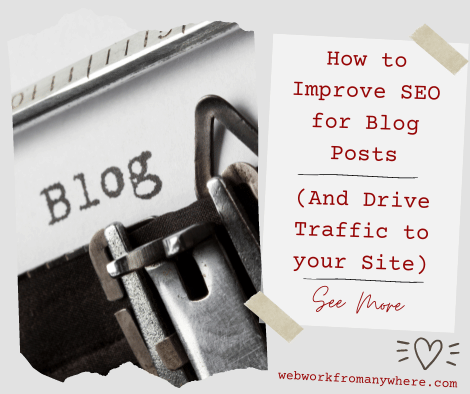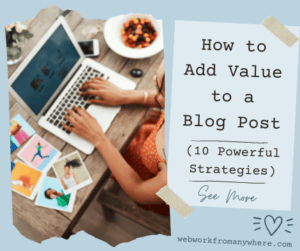Navigating the maze of Search Engine Optimization (SEO) can feel daunting, but it’s your secret weapon to stand out in the sea of competitive content.
Think of SEO as the beacon that guides your audience right to your blog’s doorstep. It’s not just about pleasing Google’s algorithm. You want to create a seamless experience for your audience.
So today let’s look at How to Improve SEO for Blog Posts with easy strategies and turn your content into traffic magnets.

1. Master Keyword Research Like a Pro
Before you type a single word, know what your audience is searching for. What are their problems? What do they need help with?
To find your audience and their concerns search on forums and social media groups like Facebook Groups.
Some of the biggest groups on Facebook are Cheap Meal Ideas, Netflix Recommendations, Home Buddies, DIY on a Budget, Fashion House, Make-up Artists, Girls Love to Travel. So you can see some themes here: travel, cooking, interior design and decoration, beauty, and entertainment.
But you can find a group for whatever niche you’ve chosen from health to personal finance to pets to gaming to motorbikes!
To Do
You can also search for your keywords on Google and check out ‘People Also Ask’. These are up-to-the-minute searches. You can then create FAQ-style posts and problem-solving posts.
For example, blog posts in the personal finance niche: ‘Feeling Paycheck to Paycheck? 5 Steps to Break the Cycle’, or “Are You Saving Enough for Retirement? A Reality Check and Action Plan”
See Also: How Do I Find Popular Keywords that are Easy to Rank For?
Keyword Tools
To find relevant longtail keywords with a decent search volume but aren’t too competitive, use tools like:
- Jaaxy
- The Hoth Free Keyword Tool (free)
- Small SEO Tools Longtail Keyword Generator (free)
- AlsoAsked Keyword Tool (free limited use)
Once you’ve got your keywords, sprinkle them naturally throughout your post—title, headings, intro, body, and conclusion.
Remember, trying to squeeze in your keywords can make your post read like a robot wrote it! Write for your audience and keep it readable.
Try Jaaxy Keyword Research (sign up required)
2. Optimize Your Blog Structure
A well-structured post invites readers in and keeps them there.
People tend to scan read so break your content into bite-sized paragraphs with easy-to-scan subheadings.
When I say a paragraph, these can be just 1 or 2 sentences.
To Do
- Use H1 for your title
- H2 for main headings
- H3, H4, and H5 for subheadings
- Create lists like this one
- Include an external link, e.g. Wikipedia
- Finish the post with a call to action
This isn’t just about looks; it’s about making your content digestible for search engines too.
And don’t forget about your URL—keep it short, and sweet, and it must contain your keywords.
- The Jaaxy Keyword Tool for High-Performance Keywords
- Unlock Your Audience’s Secret Questions with AlsoAsked
- How to Improve SEO for Blog Posts

3. The Magic of Linking
Links are important when we want to know how to improve SEO for blog posts.
Links are the streets that connect your posts within your blog, to the internet, and to your audience. Let’s look at internal links and external links.
Internal Links keep readers on your site. They reduce bounce rates and show Google (and Bing, etc) that your content is interconnected and valuable.
To Do
Once you publish a post, link to this post from older higher authority posts. This strategy helps distribute “link juice” (SEO value) more effectively.
Anchor Text
For best practice SEO use anchor text links on your blog post. These highlighted links describe the content you’re linking to. This gives your audience and the search engines context about what to expect.
For example, “learn more about SEO” is an anchor text. It links to a post about Search Engine Optimization (SEO). “Click here” is not anchor text, since it doesn’t provide any descriptive information about the destination
Just ensure all links are relevant and add value to your content.
External Back Links from reputable sites boost your credibility and your domain authority. But they’re difficult to get!
One way you can create backlinks to your site is to create business profiles on social media and websites you can join. According to Jay at Wealthy Affiliate, these are foundational links and are very important.
Don’t worry about regular posting, audience numbers, writing all the time, etc on these sites. The important detail is that you have a strong presence on search.
When you google your website/blog you look like a business with membership to all of these organizations.
To Do (not necessarily all of them!)
- Create a Facebook and Instagram Page.
- Create a Pinterest business
- Create an X (formerly Twitter) account
- Join Medium, and write articles
- Create a YouTube account
- Create a LinkedIn business page
- Join Crunchbase
- Create your own SubReddit on Reddit for your blog/business

4. Add Visual Elements
Text is great, but mix it up with images, videos, or infographics to make your posts pop.
Not only do they make your content more engaging, but they also offer additional opportunities for SEO through alt text and file names.
To Do
- Add alt text, title, and description to your images
- Add a YouTube video to your post if it adds helpful content
- Use Canva to create images (like the ones I’ve used on this post)
Remember, the internet is a visual space. Captivate your readers with multimedia elements that complement your words.
5. Add your Post to URL Inspection
The only way to know if your SEO efforts are paying off is to track your progress. To see how well your posts perform use Google Analytics, Google Search Console, and Bing Webmaster Tools.
Fresh content alert! Once you’ve hit publish on your new blog post that’s bursting with valuable insights, let Google and Bing know it’s ready to be discovered by the world!
To Do
- After you’ve published a post, add the URL to the URL Inspection Tool at Google and Bing
- Add the link to your post to social media, eg. Facebook, Instagram
To see how well your blog posts perform, look at Google Analytics, Google Console, and Bing Webmaster tools to see the traffic, the posts with the most clicks, the bounce rate, and the time spent on the page.
The Difference Between Them
Google Analytics tracks website visitors, including demographics, page views, and user actions.
Benefits: Analyze user behavior, optimize website content, measure marketing campaign effectiveness, and gain valuable insights to improve your online presence.
Google Console focuses on how your website appears in search results, letting you see what terms people use to find your site and identify areas for improvement.
Benefits: Improve search engine ranking, fix technical issues, and understand user search behavior.
Bing Webmaster Tools: Like Search Console, it helps you manage your website’s presence in Bing search results.
Benefits: You can submit your sitemap, monitor crawl errors, and analyze keyword performance.
Improve Bing search ranking, identify technical errors, and understand user search behavior on Bing.
These insights in Google and Bing help you tweak your strategy and give your audience more of what they love.
Key Takeaways: How to Improve SEO for Blog Posts
Improving your blog’s SEO isn’t a one-off task; it’s an ongoing journey of optimization and refinement.
Start with thorough keyword research, structure your posts for easy reading, link with intention, captivate with multimedia, and keep a close eye on your analytics.
Remember, your goal is to provide value to your readers while making it easy for search engines to discover your content.
Keep these key takeaways in mind, and you’ll see your blog’s visibility soar. Now, go give your posts the SEO boost they deserve!
P.S. Hi Friends – I hope this post ‘How to Improve SEO for Blog Posts’ has benefited you and you’ve gained some insights.
Feel free to share your own ideas and If you have any questions, feel free to pop them in the comments below. I will get back to you ASAP.
Check out my latest value-packed posts about niche research and affiliate marketing to help your business progress. Please share if you think this will help your friends and networks.
Also, see my Number 1 recommendation for the top blog training online where I learned the craft.
Determined to help you succeed, Alisa







